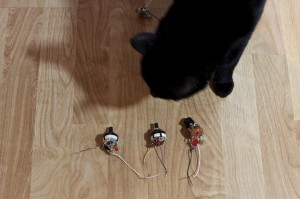
My cat hates when I play distortion pedals. I don't think he especially appreciates my non-distorted playing either.
Reader Derick just posted a comment on the DIY Project #1 page about his experiences with using different diodes for the Bad-Ass Distortion Pedal project. He’s inspired me to share a few cool tools you can use to make your DIY work easier and more creative. If you’ve worked through some of projects, or think you might, you should think about adding some of these to your workbench.
First up: A signal probe. This is practically indispensable for troubleshooting circuits once you perfboard them. If your circuit makes no sound (or not the sound you expect), you connect the jack end of the probe to an amp, and then touch the wire at the other end of the probe to various points in your circuit and listen whether the signal is getting through. You generally move the the circuit in sequence: “Okay, the sound is getting to the first capacitor. Okay, it’s leaving the capacitor as expected. What? No sound from the first transistor’s collector? I’d better double-check my solder joints on the transistor and make sure it’s oriented properly.” Add a few curse words, and you have a pretty typical scenario. The signal probe is also a good educational tool, because it lets you hear exactly how each component modifies the sound.
It’s ridiculously useful and simple. Just solder two wires to the lugs of a mono jack (preferably white for the outer, “hot” lug, and black for the inner ground lug). Solder one leg of a .1uF capacitor (also know as a 104 or a 100n) to the white wire. Next, solder another wire to the other leg of the cap. That’s it — just wrap the connections in electrical tape.
To use it, unplug the cable from the jack that normally sends your signal to an amp, and plug the amp cable into the signal probe’s jack. Plug the probe’s ground wire into your breadboard’s ground bus. (Or if you’re working with perfboard, use an alligator clip to connect to any ground connection on the board.)
You can also buy a $12.95 signal probe kit from Build Your Own Clone that includes a nice, sealed jack and a proper multimeter-style probe. Or you can buy these parts from any electronics supply house and save a few bucks.
Tool #2 is a sturdy breadboard rig. This is a little more ambitious, but if you think you might carry on with this DIY nonsense, it’s definitely worth the trouble. The basic idea: Get a nice, stout plank, batten down your breadboard with Velcro, and add permanent input and output jacks, and possibly other tools. Here’s one I made:
Using a spare stompbox enclosure, I attached permanent input and output jacks and an easily replaceable battery. The stompbox also has a 9v jack I can use to power my projects.
For a much more attractive version, check out the Beavis Board, created by my fave DIY writer, Dano from Beavis Audio Research. He used to sell these, but no longer does. But all the instructions and specs are yours for the taking.
The third useful/easy/cheap tool brings us back to Derick’s original comment. It’s a quick way to compare the sounds of related components by attaching them to a rotary switch like this one from Jameco. I made some “diode testers” to audition how different options might sound within a circuit.
Just round up a bunch of different diodes, solder one leg of each to one of the outer lugs, and then twist together all the other legs — plus a length of wire — and solder the mess together. Attach a wire to the switch’s inner lug. Plug these two wires into your breadboard anywhere a distortion diode should reside, and then turn the dial to hear all the options. Better still are two or three of these contraptions, so you can audition the dual- and triple-diode options as well. I guarantee you’ll discover cool sounds you never would have encountered if you were popping the diodes into the breadboard one by one.
This trick also works well with capacitors. Just populate one of these switches as detailed above, but using successive cap values. It’s great for, say, selecting the perfect input cap value. In fact, that’s exactly how the input cap selector works in the Divided By 13 Dyna-Ranger, one of the best-sounding Rangemaster derivatives. A big switch like this is often overkill — it might be better to narrow down your choices and uses a smaller two- or three-position switch. But if you really want to switch between twelve different diode sounds, well . . . )
One bonus tip: You might want to pick up a roll of bus wire. This is a stiff, strong wire that tends to feel more like a coat hanger than the light, floppy stiff we usually use. Some builders like to use it inside their pedals. (Upside: neater-looking and study. Downside: Harder to work with.) Bus wire is great for anything that will undergo a lot of handling, especially things that are likely to be plugged into a breadboard over and over. It’s a great choice for making some of the tools I’ve described.
Tools like these are awesome when it comes to customizing your sound. I totally understand why so many builders make strict clones — it’s how you learn! But it’s only through trial-and-error experimentation that you make these instruments yours.
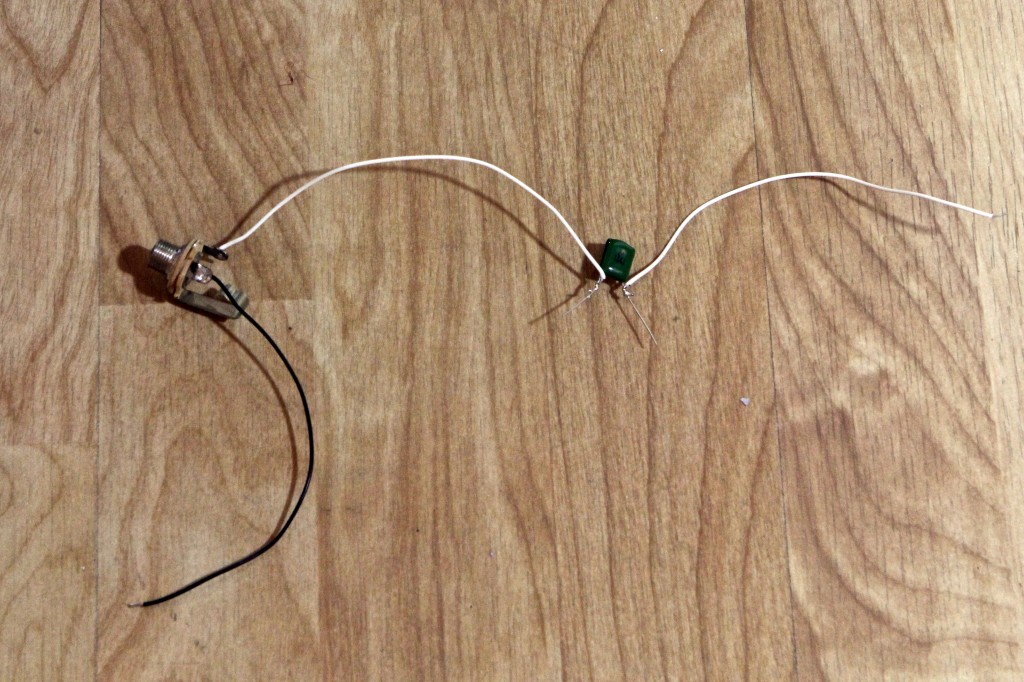
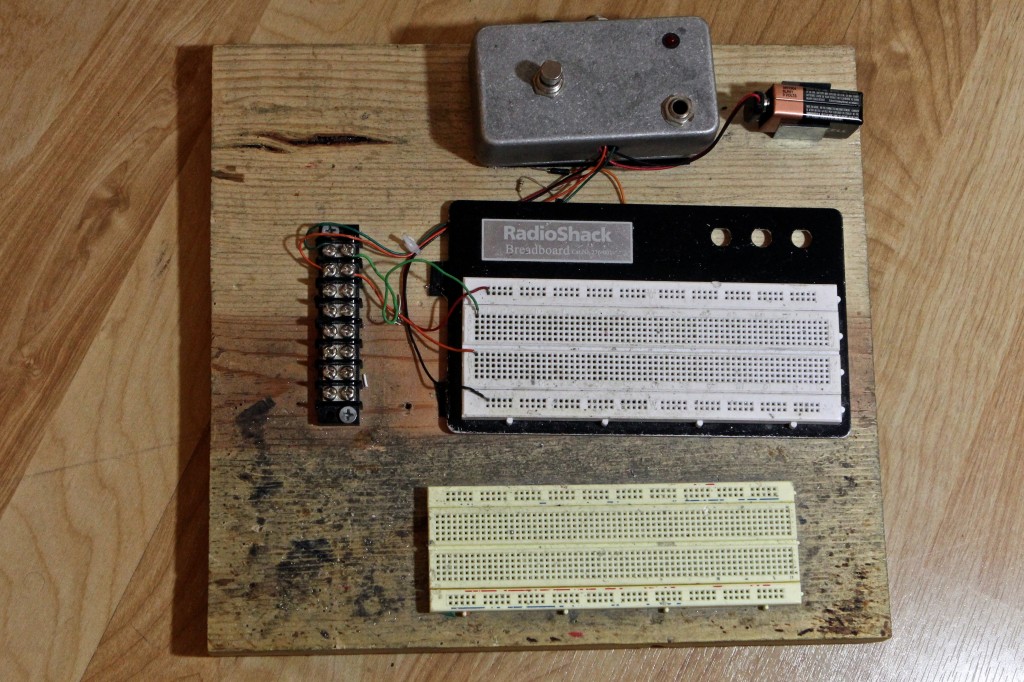
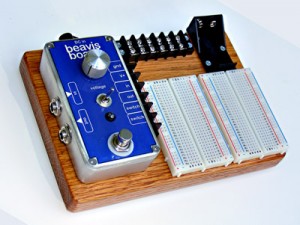

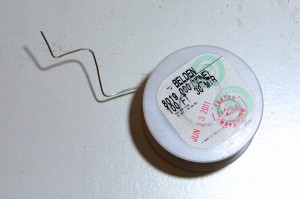








On the Diode Tester, I put together a box of various semiconductors wired to two 6-way switches and a trio of DPDT toggle switches that gives me 15 different options. It’s wired to a stereo 1/4″ plug so I can wire a matching jack into the clipping stage of a pedal design to audition different clippers.
Oh man, do you by any chance have a picture you could share? I’ve done something similar, basically auditioning various diode clipping stages using what looks like two Vari-Tone assemblies. The only catch is, I don’t like diode clipping all that much! 😉
I’ve tried a few builds and keep getting the same problems – uneffected sound, but no effected sound or no sound at all. I’ve been stupid enough to box them before auditioning them, so I want to build a test rig. Any chance you could explain where wires go & come from? Thanks & Happy New Year!
Hi Chris, and Happy New Year 2016!
This article makes more sense after you’ve built a pedal and learned some of the basics. There are several “build your first pedal” tutorials on this site in the DIY Club section — but I recommend this article, which I wrote for Premier Guitar a couple of years ago: https://www.premierguitar.com/articles/21291-build-your-own-stompbox
It’s an updated version of the tutorials on this site,with better graphics and fewer typos. Hope it helps! 🙂